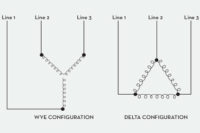Compared to single-phase motors, it’s unusual for a three-phase motor to be in a locked-rotor situation. Either an extreme voltage drop at the compressor terminals or a mechanical defect in the compressor will prevent the motor from restarting.
However, all three-phase motors that run continuously in air conditioning or large freezer systems are susceptible to overheating if there is a voltage imbalance in one of the phases. This situation often develops when there’s an uneven distribution of single-phase loads, either from a nearby panel or throughout the premises.
The most hazardous condition happens on a hot day (full load) combined with an imbalance of 3%, and a slow rise in motor winding temperature of about 5°F an hour. The heat can hover close to the insulation breakdown temperature before the thermal overload is activated.
Each time the winding insulation is overheated, the slight breakdown is accumulative and irreversible. Unless the voltage imbalance is corrected, the three-phase motors that run continuously will eventually burn out.
Another reason for voltage imbalance is a worn or badly pitted set of contacts in the motor starting contactor. This condition can be easily tested by first shutting off all current to the contactor, and measuring the ohms across each set of contacts as you manually push the armature to the “on” position.
Cleaning pitted contacts has proven to be a temporary emergency measure to keep the compressor running. All the contacts or the contactor itself should be replaced.
SINGLE PHASING
Single phasing presents a difficult problem if its motor starter doesn’t have a single-phase protection feature.If the loss of one phase occurs before the motor attempts to start, the motor will be in a locked rotor condition, but the amperage will be far less than if all phases were in the circuit. And if the overload device was not calibrated for this condition, the two phases of the motor would burn out in about 5 min.
If one phase goes out while the motor is running, it will keep running if the load is light, but the amperage will be more than twice its normal full-load amps; the two remaining phases can burn out in about 10 min, which may require a lot of clean up.
PRECAUTIONARY MEASURES
Say you are on a job where the air conditioning system has a slow leak. You found the source of the leak, repaired it, added refrigerant, and you’re now checking out the system. Superheat, head and back pressure, volts and amps, everything looks OK.Is it? How about the motor?
In most cases of a slow leak, the compressor could have operated for days with a high superheated return to the unit, providing no cooling to the motor. Were the windings overheated and the overload protector energized? What is the condition of the winding?
On a call where the compressor won’t start, you notice that there’s a “blown” capacitor. You correctly assume that the relay is defective, so you change both the relay and the capacitor. In checking out the system, you find that the voltage, amperage, and refrigerant charge are OK.
Is everything really fine? How long was the compressor cycling on the overload condition before someone shut down the unit? Was the winding overheated and damaged?
On all service problems where the motor protector was energized, the integrity of the windings’ insulation should always be questioned. The best answer to all of the above questions is to use the megohmeter. It is one of the best diagnostic tools available. Sound business practices and smart service policies not only dictate the use of this instrument, but to always record the readings on the service invoice.
A reading of 80 to 100 megohms from terminal to ground is considered good (1 megohm equals 1 million ohms); 40 to 50 megohms are indications of a slight breakdown in the wire insulation, or possible oil contamination.
Here is a typical case where the megohmeter avoided a nasty situation.
A technician arrives on a job where a 3-ton central air system wasn’t cooling properly. The tech noticed that the condensing fan was just barely turning over. The condenser was hot and the compressor was too hot to touch. The fan was free turning but the motor was dead.
The tech called his supplier and was told there was a replacement motor in stock. Before he went to get the motor, he checked the compressor with his megohmeter and got a reading of 20 megohms. He informed the customer that the winding was damaged and he couldn’t predict how long it would last. He was told to go ahead with the repairs anyway. It was an expensive repair job and he recorded the megohm reading on the bill.
Two weeks later, the motor grounded out.
Now the customer is faced with an overwhelming cost of a new compressor, after already paying out a high repair bill. If the customer wasn’t warned initially on the condition of the winding and if the megohm reading was not recorded, you can well imagine the litigation that could have followed.
Ehren is a long-time refrigeration expert at Sealed Unit Parts Co. Inc., 2230 Landmark Place, Allenwood, NJ 08720; 732-223-6644.
Publication date: 09/04/2000

